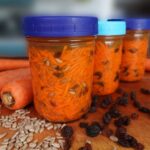Fermented Carrot Salad with Raisins
Enhance your meals with this delicious, probiotic-rich fermented carrot salad. The fermented salad is ready in just 48 hours & is low in sodium!
Equipment
- 1 Wide Mouth Jar + Lid pint size or 475 ml
- 1 Fermenting Weight optional
- 1 Spice Grinder optional
- 1 Tamper optional
- 1 Canning Funnel optional
Ingredients
- 2.5 c Carrots Shredded
- ¼ c Raisins
- 2 tbsp Sunflower seeds
- ½ tsp Cumin Seeds
- ¼ tsp Salt Use a salt that does not contain anti-caking agents
- ¾ c Water
Optional Substitutions
- 2 tbsp Chopped walnut pieces or almond slivers (Instead of sunflower seeds)
- 1 tsp Dried dill weed OR Italian spice blend (Instead of cumin seeds)
Instructions
Step 1: Prepare The Carrots
- Shred the carrots with either a food processor or hand grater, then add them to a mixing bowl.You may opt to peel the carrots, but it is not required.
Step 2: The Additions
- Add the raisins and sunflower seeds to the bowl of shredded carrots. Remember you can substitute the sunflower seeds with almond slivers or walnut pieces.
Step 3: Prepare The Cumin Seeds
- If you’re going to use whole cumin seeds, you’ll need a little spice grinder to freshly grind them.The fresh grinding of the seeds is responsible for explosive flavor, incredible aroma and the release of bioactive compounds such as anti-inflammatory polyphenols.Once ground, sprinkle over the other ingredients in the bowl.
- Alternatively, you can add dried dill weed or an Italian seasoning blend if you choose not use cumin seeds. Using either of the herb flavors will create a delicious fermented carrot salad!
Step 4: Prepare The Brine
- Add the salt to the water and mix thoroughly to incorporate the two.
- Pour the brine over all the contents in the bowl.
Step 5: Mix It Up
- With clean, washed hands, toss all the ingredients around in the bowl and make sure everything becomes coated with the brine.
Step 6: Prepare The Equipment
- Before loading the jar, wash it in hot soapy water. There is no need to sterilize the jar, hot soapy water is sufficient. Remember to wash the fermenting weight as well.
Step 7: Load The Jar
- Place a couple of handfuls in the jar. I like to use a canning funnel when loading the jar because it significantly reduces spilling.
- Next, use a little tart tamper to pack the mixture down in the jar.
- Add 2 more handfuls of the carrot mixture and pack down again.
- Lastly, add the remaining contents from the bowl and press down once more. It should be nice and soupy by time all the contents are added.
Step 8: Add The Fermenting Weight & Lid
- Add the fermenting weight and press it down firmly. If you don't have a fermenting weight, don't fret. With this particular recipe, it's ok not to use one.
- Question: Why can I opt out of using a fermenting weight with this recipe and not other fermentation recipes? Because this recipe ferments for such a short period of time, no mold will have an opportunity to develop.
- Place a loose lid on the jar.The loose lid will allow for the fermentation gasses to escape which eliminates the need to burp the jar.
The Fermentation Period
- Leave on the counter to ferment at room temperature for 24 to 48 hours. A towel or a plate placed underneath will catch the brine overflow that will occur once the fermentation gets going.
- Depending on where you live in the world and the environmental conditions, the fermentation speed can vary. In temperate climates, 48 hours is the optimal fermentation period because it produces the best flavor without over-fermenting. *If you are not familiar with the term, an explanation is provided in the blog of what 'over-fermentation' is.
- If you live in a hot & humid climate, give the carrot salad a taste test around 24 hours. You may find that at 24 hours, it already has that perfect zingy flavor created by the fermentation process. This is because extra warm environments speed up the rate of fermentation.
- Whether your carrot salad has been fermenting for 24 or 48 hours, if you taste it and it has that strong fermentation zingy-sour flavor, go ahead and end the fermentation. But if you feel it needs a little more pop, allow it to ferment another day on the counter, simply follow your pallet.
Ending The Fermentation
- To end the fermentation, first remove the fermenting weight. Then with a clean fork, reach in and take a bite!
- To store, keep the weight out of the jar and place a tight lid on. Keep it in the refrigerator where it will last about 7 to 10 days before over-fermentation takes place.*If you are not familiar with the term, an explanation is provided in the blog of what 'over-fermentation' is.
